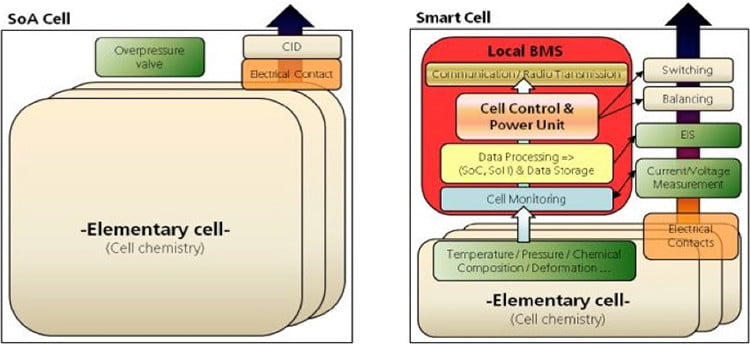SMART-LIC battery management system (June 2013)

Current limitations of battery systems for fully electric vehicles (FEV) are mainly related to performance, driving range, battery life, re-charging time and price per unit. New cell chemistries are able to mitigate these drawbacks, but are more prone to catastrophic failures due to a thermal runaway than current solutions. Therefore, new and more advanced management strategies are necessary to be able to safely prevent the energy storage system from ever coming into this critical situation.’
SMART-LIC addresses a novel battery management system (BMS) architecture, which is able to meet high requirements of safety, acceptability in terms of costs and performance. The main idea is to introduce smart “satellite” systems on the lowest possible granularity between individual cell and macro-cell. Integration of electronic and thus development of novel packaging technologies for smart satellite systems are part of the project.


Figure: Schematic drawing of a state-of-the-art lithium-ion cell with incorporated passive safety features (left) and of the proposed smart lithium-ion cell with incorporated smart system.
In order to achieve cost targets in preparation of industrialization and series use, focus was also put on standardization questions. One major input that influenced SMART-LIC just after its start in 2011 was the introduction of the standard of 48V for heavy load on-board power supply and with micro-hybridization a first step towards electric mobility at reasonable costs.
Consequently, the project was adapted in order to address this new voltage standard with its topologies allowing use at 48V or multiple of 48V (e.g. 240V).
The Smart-LIC battery management concept includes wireless data transfer and electrochemical impedance spectroscopy. The latter has been adapted in order to implement it on automotive embedded solutions with a minimum cost impact. This allows state determination and lifetime prediction on single cell level based on in-system measured data.
In general an increase of the temperature of a lithium-Ion cell leads to reductions in lifetime. In the worst case, it can also lead to cell destruction and thermal runaway.
Smart-LIC will allow tightening the control of small cell packages and thus higher exploitation of the battery whilst achieving increased total lifetime. In consequence a reduction of the costs-of-ownership can be expected.
Partners of the project are STMicroelectronics (coordination), Centro Ricerche Fiat, Conti Temic Microelectronic GmbH, Fraunhofer Institute for Electronic Nanosystems ENAS, KEMET Electronics Italy, Technische Universität Chemnitz, Berliner Nanotest und Design GmbH.
The work reported is part of the European project ‘Smart-LIC’, which has been fruit of brokering inside the EPoSS community. It is actually funded through the Green Car initiative in the FP7 framework. It shall continue until 2014.


